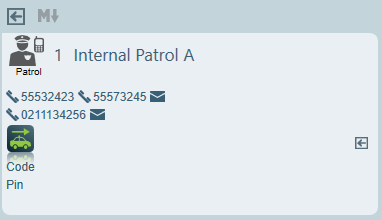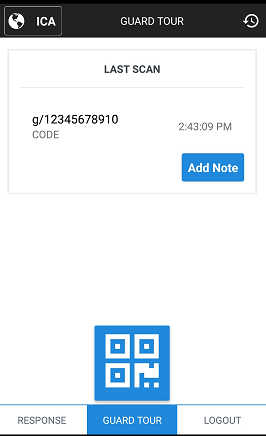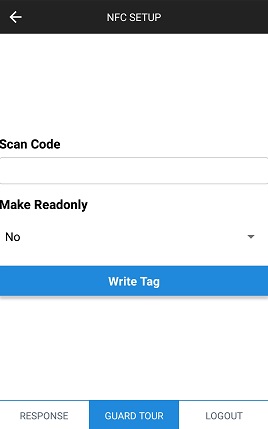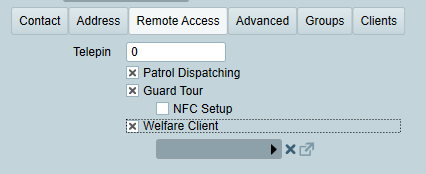The Patrol Response module adds additional features to the Plink smart phone application, including Patrol Response, Guard Tours, and Welfare Checks.
This module is intended to allow operators to send dispatch requests to Patrol Guards who are equipped with the plink smart phone app. The guards can then respond to the request and give feedback as they respond. Typically, the Patrol Response module is used by a monitoring company who performs their own response using their own internal guards, or a dedicated dispatch company who has their own guards.
Patrol Guards are setup as users in Patriot. They can be given Patrol Response access on the Remote Access tab of the user from User Maintenance.
Options for Patrol Dispatching, Guard Tour, and Welfare Client access are available. Each user can be given access by enabling these options as required.
The Patrol user must also have ICA access configured, with a suitable username/password. The user only needs to be assigned read only level of access to ICA.
It is recommended that you link all of your patrols to a Select Patrol Dispatch user which represents the parent patrol company (even if the parent company is your own company). This gives you the option to add the parent patrol company to your response plans instead choosing specific patrols for clients ahead of time - this means that the best situated patrol can be selected via a map during the activation response. If you dispatch to multiple external patrol companies, or to a mixture of external patrol companies and your own internal patrols then the Dispatch module is strongly recommended to help you with your dispatch patrol selection.
This option is typically enabled on your internal patrol company dispatch user. It allows you to dispatch a job directly to the best situated patrol belonging to the internal patrol company. Under some circumstances you may be able to enable this option on an external patrol company's dispatch user. To use this option you need to know the full contact details of individual patrols belonging to the patrol company and for the best experience it is suggested for the patrols to use the Patriot Plink app to receive dispatches. Meanwhile Manual Dispatch and Web Dispatch are also supported.
Note: "Patrol Company" user type needs to have User Kind set to "Dispatch User" in Maintenance -> Users -> User Types.
Each patrol belonging to your internal patrol company needs to be loaded as a standard Patriot user. On the remote access tab the internal patrol company must be selected.
Currently Select Patrol Dispatch option is supported by Plink Dispatching, Manual Dispatch and Web Dispatch.
If your internal patrols will use the Patriot Plink app to receive dispatches then the Plink Dispatching option should also be enabled.
If your internal patrols are not using the Patriot Plink app but receiving manual or web dispatches, the Manual Dispatch or Web Dispatch option should be enabled respectively.
Select Patrol Dispatch: select the user representing the company the patrol belongs to.
Patrol Dispatch Client: select the client that the patrol's availability will be reported to. The Patrol Dispatch Client should use the Patrol Dispatch Availability template, available from the Patriot Templates Library. If the patrol is using Plink, the availability status will be reported by Plink and logged against this client. If the patrol is not using Plink you can update the availability status manually by logging a set or unset signal against this client. The set signal will mark the patrol as offline/unavailable, while the unset signal will mark the patrol as online/available.
If the patrol is using Plink, it is also recommended to enable Welfare Client option and select a client that the patrol's GPS location will be reported to. The Welfare Client should use the Patriot Patrol Welfare Checks - Plink template, available from the Patriot Templates Library. Patriot will use the location information logged by this client to display the patrol on the map. It's recommended to use a single client with different areas for the Patrol Dispatch Client and Welfare Client settings.
On the Dispatch tab you can now assign one or more Patrol Dispatch Groupings. These groupings can be used to filter patrols from the patrol selection map when responding to an activation. By default only patrols with a dispatch group matching those assigned to the client are displayed to the operator. Note that the client group type used for this purpose is configurable in Patriot's system wide settings.
Within the app, the Patrol user can now follow the standard registration process for Plink, using the monitoring station code and their ICA username/password, as described in the Plink documentation. Once the Patrol has logged in, they will have additional options available along the bottom of the app.
Ensure that Plink Dispatching or another dispatch method is enabled for the all the patrol users that can respond to dispatch requests as covered in General Setup above.
For an operator to send a dispatch request for an activation to a Patrol user, that patrol user must first appear on the Response Plan of the activation. This can be achieved easily using the optional Dispatch module, or if you only dispatch to your own internal patrols, then the internal patrol company or specific patrol(s) should be pre-assigned to your client response plans.

A specific internal patrol "A" directly assigned to a client response plan.
![]() If you are dispatching to an internal patrol company
or an external patrol company with the Select Patrol Dispatch
option enabled, you can select and dispatch to the best situated patrol during
the activation response.
If you are dispatching to an internal patrol company
or an external patrol company with the Select Patrol Dispatch
option enabled, you can select and dispatch to the best situated patrol during
the activation response.
When your dispatch patrols have Welfare Client (location tracking), Patrol Dispatch Client (dispatch availability) and Plink Dispatching enabled it is easy to choose the best situated patrol to receive a dispatch. Patrols can be selected via a map directly from the activation response. Patrols that are not currently linked to a job are displayed in black. Patrols that already have dispatch job(s) assigned are shown in white and patrols assigned to the current job are displayed in orange. Note that the dispatch patrol selection tool does not automatically update patrol locations but there is a separate Patrol Location tool located in the main Monitoring menu that does automatically update patrol locations.
By default, only patrols who have indicated they are available are displayed, but unavailable patrols can be viewed if required and appropriate.
If your dispatch patrols are not using Plink app, they will not be able to report their location, thus will not be displayed on the map. But you can still select them from the list on the left.
![]() Once a patrol user that supports a dispatch method (Plink, Web
etc.) is added to the response plan, the operator now has the ability to
dispatch activations to the patrol. When activation is dispatched a
notification will be sent to the patrol, who can either accept or release the
activation
Once a patrol user that supports a dispatch method (Plink, Web
etc.) is added to the response plan, the operator now has the ability to
dispatch activations to the patrol. When activation is dispatched a
notification will be sent to the patrol, who can either accept or release the
activation
When selecting a pending patrol response job, the Patrol will see details of the job, such as alarm details, site details, and instructions.
The patrol then has several options available during the response:
Accept: The patrol accepts the job, and will travel to site to respond to the alarm.
Release: The patrol is unable to respond to the alarm. This will notify the operator to re-assign the job to another patrol.
On Site: The patrol has arrived on site.
Left Site: The patrol has completed their response and has left the site.
Add Note: Allows the patrol to enter additional response notes and observations.
All actions are transmitted back to the operator and recorded in the alarm response.
Patriot zones can be configured with scan codes, which can be scanned by a patrol during a guard tour.
Scan codes can be entered on a zone record, along with a desired scan frequency.
A Scan Code Exceptions Report is available to report on zones which have not been scanned at the correct frequency.
The following signal types need to be added to the relevant templates:
65550: Patrol Guard Tour Scan
65551: Patrol Guard Tour Note
During the guard tour, the Patrol will be able to scan the pre-configured codes to indicate that they have checked the surrounding area.
Notes can also be added after the scan process, to report additional observations.
All actions taken are logged against the client associated with the scanned zone. Unknown/invalid scan codes will be reported to SYST(1)-01.
The app supports the scanning of NFC tags and Data Matrix codes.
NFC tags will be read whenever the phone is places within a short distance of the tag. When a tag is read, the app will be automatically opened (if not already), and the new tag read will be displayed on the Guard Tour page within the app. To read an NFC tag, the phone must have support for NFC.

New NFC tags can also be written using the app. The User logged into the app must have NFC Setup access, as specified from the Remote Access tab of the user. From the Guard Tours page, select the NFC Setup button,

NFC Setup Button
This will open the NFC Setup page. Enter the unique NFC Code into the Scan Code field.

NFC Setup
Compatible NFC Tags
Any blank tag which has had the data written to using the plink app, will be compatible.
If the tags used have pre-written data by some other means, it gets a little more complicated, as there as different formats for encoding the data. If the data is written as a text record (NDef type of Text), which is a common format, then we support this format. If you are going to purchase the tags from a supplier, and get the data written to the tags as part of the purchase, then make sure you specify the format as text. It would be a good idea to purchase a small number first to ensure the format written is compatible with the app.
To read a Data Matrix Code, from the app select Guard Tour, then click the Data Matrix Scan button,

This will open the camera to allow for the scan of the code. Place the code within the guide box on the screen. The torch can also be turned on using the torch button. Once turned on, it will default on the next time a scan is made.
New Data Matrix stickers can be generated using this webpage within the Patriot support portal, Data Matrix Code Generator
Create a new action plan, called 'Welfare Check overdue'. This should be a priority event. Use Action Plan Scheduled Actions to redirect to a non-priority event while the site is closed.
Import the Welfare Checks template from the Patriot Templates Library, and ensure that the Welfare Check Overdue event (type 65002) is using the new Action Plan.
Set up a new client for each Patrol/User who requires welfare checks. Assign the designated client to the user from User Maintenance, Remote Access tab of the User. With Welfare Client enabled, a client selector will display allowing selection of the client. If Patrol Dispatching is being used as well, it is recommended to use multiple areas on a single client.

This welfare client needs to have the following settings:
Type template: Needs to be set to the Welfare Checks template imported above.
No Signals Monitoring: Needs to be set to the welfare check frequency (e.g. 30 minutes). If required, alter the reset time to avoid extra events outside of the patrols active hours.
Schedules: An opening event is sent when the patrol enables welfare checks, and a close event when they disable welfare checks. Patrol hours and late to open/late to close can be set up if required.
Mapping: If the mapping module is enabled, set 'Mobile Client' active on the client, so that location events will be displayed.
Once configured, the Patrol has the following options available:
Enable/Disable Location Tracking: Begins/ends background location tracking. When this is enabled location signals will be logged in Patriot every few minutes. If the device is either unable to obtain a location or fails to log the location to the Patriot Server the Plink User is notified.
Enable/Disable Welfare Checks: Begins/ends a patrol shift, and starts/stops welfare check monitoring.
Send Welfare Check: Sends a welfare check to the monitoring station, resetting the welfare check timeout.
Send Duress Alarm: Sends a duress/panic alarm to the monitoring station, requesting immediate assistance. Dress alarms can be sent via smart buttons, e.g. Flic button. See the Flic iOS documentation for how to setup Flic on iOS to send duress alarms.
All actions taken are logged against the configured patrol account.
Welfare check and duress events and location tracking signals will include the patrols location, which operators can view from the Mapping tab, if the mapping module is registered.